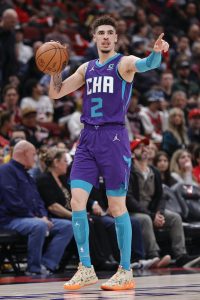This is the 12th and final entry in our series breaking down the major trades of the 2022 offseason. As opposed to giving out grades, this series explores why the teams were motivated to make the moves. Let’s dive into a deal between the Jazz and Pistons…
On September 22, the Jazz agreed to send Bojan Bogdanovic to the Pistons in exchange for Kelly Olynyk, Saben Lee, and $1,752,638 in cash – that amount was the exact cap hit for Lee, who was subsequently waived before the season began.
The Jazz’s perspective:
None of the players involved in this deal are stars, but it was still a pretty surprising move because most league observers thought the Jazz would receive a young player and/or draft assets for an efficient scorer and shooter like Bogdanovic. So why didn’t they?
For starters, Bogdanovic is playing on a $19.55MM expiring contract, which made matching salaries difficult since nearly every team is over the cap (more on that later). He was rumored to be looking for an extension, which may have impacted his trade value since he’s 33 years old and most contending teams are taxpayers. Bogdanovic also has some clear limitations as a player, which we’ll get into.
By acquiring Lauri Markkanen and Jarred Vanderbilt (in separate trades), the Jazz had a couple of younger players to start at the two forward spots. That made Bogdanovic, another forward, redundant to some extent, and there’s no reason why he’d be interested in a reduced role when he’s still playing at a high level.
Reports after the trade indicated that the Jazz received late first-round pick offers for Bogdanovic that required them to take back longer-term salary, so Utah instead chose to create additional financial flexibility. The Suns reportedly pursued the veteran, but also wanted Vanderbilt in the deal, which caused the talks to break down.
It’s one thing to move an expiring veteran, but Vanderbilt is only 23 years old, under contract for two years, and is one of the league’s most energetic rebounders on top of being a plus defender, making him a coveted asset. It’s understandable why Utah didn’t want to deal him so soon after acquiring him.
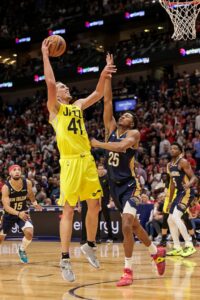 Instead of receiving draft compensation, the Jazz saved $6.75MM ($5MM against the cap) in 2022/23, because Olynyk makes $12.8MM this season. Clearly Lee — a guard who was the 38th overall pick in 2020 — wasn’t in the team’s plans, but Utah essentially got a free look at him in training camp with the cash received offsetting his salary.
Instead of receiving draft compensation, the Jazz saved $6.75MM ($5MM against the cap) in 2022/23, because Olynyk makes $12.8MM this season. Clearly Lee — a guard who was the 38th overall pick in 2020 — wasn’t in the team’s plans, but Utah essentially got a free look at him in training camp with the cash received offsetting his salary.
Olynyk has been a solid, productive player for a long time and the Jazz lacked a starting-caliber center after trading Rudy Gobert to Minnesota. Rookie first-rounder Walker Kessler (acquired in the Gobert deal) looks promising and could eventually become a starter, but would be a poor spacing fit with Vanderbilt, whereas Olynyk helps in that regard.
There’s an arrhythmic quality to Olynyk’s game that’s difficult to describe. He has some unique qualities for someone 6’11”, and he provides value in atypical ways for a big man.
Olynyk leverages his outside shooting with drives to the basket, creating plays both for himself and teammates. He’s an unselfish passer and is an above-average ball-handler for a player his size.
If you try to put a smaller player on him, he can score over them in the post. He’s smart and runs the floor hard looking for easy buckets. Olynyk is also versatile enough to play both frontcourt positions against bigger lineups, with first-year head coach Will Hardy deploying him alongside Kessler at times.
The Canadian veteran likes flipping up finger rolls near the rim, such as what turned out to be an off-balance game-winning shot against the Pelicans on Sunday – it’s not always aesthetically pleasing, but more often than not it goes in. That’s basically Olynyk in a nutshell — unusual but effective.
I think Olynyk’s sometimes awkward-looking play makes people take him less seriously for some reason. Maybe that’s why writers, analysts and fans alike seemed to overstate the difference in on-court impact between Bogdanovic and Olynyk when evaluating this trade.
Case in point, with the caveat that per 36 numbers are a bit misleading:
Player A’s career per 36 averages (607 games): 18.6 PPG, 4.5 RPG, 1.9 APG (2.0 TO) and 0.7 SPG on .457/.393/.862 shooting. Career advanced stats: 59.2% true shooting percentage, 33.4 win shares, 5.0 value over replacement player, 14.0 player efficiency rating.
Player B’s career per 36 averages (614 games): 16.5 PPG, 8.3 RPG, 3.4 APG (2.4 TO) and 1.2 SPG on .477/.368/.782 shooting. Career advanced stats: 59.0 TS%, 35.6 WS, 9.9 VORP, 15.8 PER.
Player A is Bogdanovic. Player B is Olynyk.
Olynyk is clearly a better inside finisher and passer, while Bogdanovic is a more prolific scorer and higher-level shooter. Neither is a great defender, though Olynyk has the edge as a rebounder and play-maker on that end.
Two big differences: Bogdanovic has started the majority of his career with an average of 29.1 minutes per game, while Olynyk has primarily been a reserve and only holds a career average of 22.0 MPG.
The main reason Olynyk has come off the bench for most of his career is that he isn’t a traditional rim protector and is a below-average rebounder for a center. Protecting the paint is the foundation of any good defense, and it’s probably his biggest weakness as a player (he’s also foul-prone). Bogdanovic doesn’t have to worry about that as much since he’s a forward.
Don’t get me wrong, Bogdanovic is definitely a better player than Olynyk. There’s no question about that. That’s why he got $73MM over four years the last time he was a free agent and Olynyk got $37MM ($28MM guaranteed) over three.
But is Bogdanovic worth an additional $5MM cap hit for one season?
In a vacuum, yeah, probably. But that’s a much tougher call with the context that Utah’s power forward spot was crowded, Olynyk filled a positional need, and reducing the cap hit this season gave the Jazz more flexibility to take on additional salary without going into the luxury tax if they opt to make more trades, which seems highly likely.
Flipping Olynyk down the line is certainly a possibility; he’d have some takers as a floor-spacing big with only $3MM in guaranteed money in ‘23/24 (he’ll make $12.2MM if his contract becomes fully guaranteed). He’s off to a strong start with the Jazz, averaging 15.5 PPG, 3.8 RPG, 3.3 APG and 1.3 SPG on .611/.786/.778 shooting in four games (28.5 MPG). Obviously those shooting splits are unsustainable, but it’s reasonable to believe he’ll have another productive season.
It’s also worth noting that Jazz president Danny Ainge acquired Olynyk’s rights when he was drafted with the 13th overall pick in 2013, and the 31-year-old spent his first four seasons under Ainge with the Celtics. That level of familiarity often plays a factor in trades.
The Pistons’ perspective:
Detroit’s side of things is easier to understand. The Pistons were one of only three teams under the cap this offseason (the Pacers and Spurs are the others), and used their remaining cap room to take on Bogdanovic’s extra salary (though including Lee would’ve allowed them to adhere to salary-matching rules anyway). That enabled them to receive a superior player without having to give up any draft compensation.
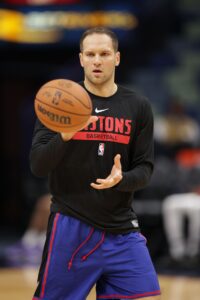 Olynyk was limited to 40 games due to injuries in his first year with the Pistons in ‘21/22 and struggled when he did play, posting career lows of 44.8% from the field, 33.6% on three-pointers, and 19.1 MPG. You’d think that may have depressed his trade value a little, but Utah didn’t seem to mind, instead focusing on his larger body of work.
Olynyk was limited to 40 games due to injuries in his first year with the Pistons in ‘21/22 and struggled when he did play, posting career lows of 44.8% from the field, 33.6% on three-pointers, and 19.1 MPG. You’d think that may have depressed his trade value a little, but Utah didn’t seem to mind, instead focusing on his larger body of work.
As with Utah’s forwards, Detroit had a crowded center rotation with Isaiah Stewart, Jalen Duren, Marvin Bagley III, Nerlens Noel and Olynyk all vying for minutes. Removing Olynyk from that equation and adding a forward in Bogdanovic made a lot of sense, because there wasn’t much depth at that spot.
I previously mentioned that per-36 numbers are a bit misleading. Here are Olynyk’s actual per-game averages from 2018-22:
10.3 PPG, 5.3 RPG, 2.2 APG and 0.8 SPG on .468/.360/.823 shooting (.605 TS%) in 256 games (108 starts, 22.9 MPG). 15.1 WS, 4.5 VORP, 15.4 PER.
Here are Bogdanovic’s over the same span:
18.3 PPG, 4.1 RPG, 1.9 APG and 0.6 SPG on .461/.403/.860 shooting (.601 TS%) in 285 games, all starts (31.6 MPG). 21.3 WS, 4.8 VORP, 15.4 PER.
It’s interesting that their TS%, VORP and PER are so similar, but Bogdanovic clearly offers more scoring and outside shooting, two key deficiencies for the Pistons last season (they were 28th in points and 29th in 3PT%). His career assist-to-turnover ratio is negative, which is never great, but he won’t be tasked with much play-making alongside Cade Cunningham and Jaden Ivey.
Young teams like the Pistons need veterans to show them how to be professionals. Bogdanovic leads by example with consistent offensive output. He was the fourth-best player on the league’s top regular season team in ’20/21, and his play hasn’t dropped off since.
While Bogdanovic has the (deserved) reputation of being a sharpshooter, his offensive repertoire is more varied than that title might suggest. He can create his own shot, he’s an above-average finisher at the rim, he can post up smaller players on switches, and he gets to the free throw line at a decent clip.
Like Olynyk, Bogdanovic has gotten off to a great start with his new club. He has been Detroit’s most effective player through five games (31.2 MPG), averaging 23.2 PPG, 3.4 RPG and 2.4 APG on .533/.512/.882 shooting.
The fact that Bogdanovic is such a strong shooter and has reached peak performance in recent seasons might portend well for the future, even if he’s 33. If he enjoys playing for the Pistons, I could see the two sides reaching a short-term extension – maybe something like two years, $40-45MM — before he hits free agency next summer.
Another positive aspect of Bogdanovic’s career is that he’s been quite durable, only missing 33 games in the eight seasons leading up to ‘22/23.
Overall, I think it was a logical trade for both sides, with Bogdanovic and Olynyk filling positional needs for their respective clubs. The Jazz gained financial flexibility by reducing their team salary, and Olynyk’s mid-sized contract theoretically makes him pretty easy to trade once he becomes eligible, if they choose to go that route. The Pistons got the better player, and hope to keep him around beyond this season.
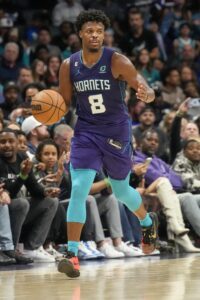 December 23:
December 23: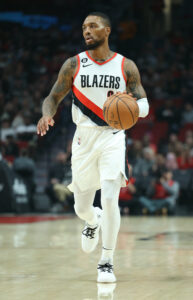 January 9:
January 9: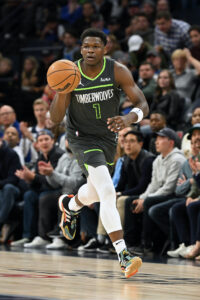
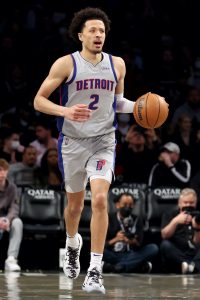
 Instead of receiving draft compensation, the Jazz saved $6.75MM ($5MM against the cap) in 2022/23, because Olynyk makes $12.8MM this season. Clearly Lee — a guard who was the 38th overall pick in 2020 — wasn’t in the team’s plans, but Utah essentially got a free look at him in training camp with the cash received offsetting his salary.
Instead of receiving draft compensation, the Jazz saved $6.75MM ($5MM against the cap) in 2022/23, because Olynyk makes $12.8MM this season. Clearly Lee — a guard who was the 38th overall pick in 2020 — wasn’t in the team’s plans, but Utah essentially got a free look at him in training camp with the cash received offsetting his salary. Olynyk was limited to 40 games due to injuries in his first year with the Pistons in ‘21/22 and struggled when he did play, posting career lows of 44.8% from the field, 33.6% on three-pointers, and 19.1 MPG. You’d think that may have depressed his trade value a little, but Utah didn’t seem to mind, instead focusing on his larger body of work.
Olynyk was limited to 40 games due to injuries in his first year with the Pistons in ‘21/22 and struggled when he did play, posting career lows of 44.8% from the field, 33.6% on three-pointers, and 19.1 MPG. You’d think that may have depressed his trade value a little, but Utah didn’t seem to mind, instead focusing on his larger body of work.